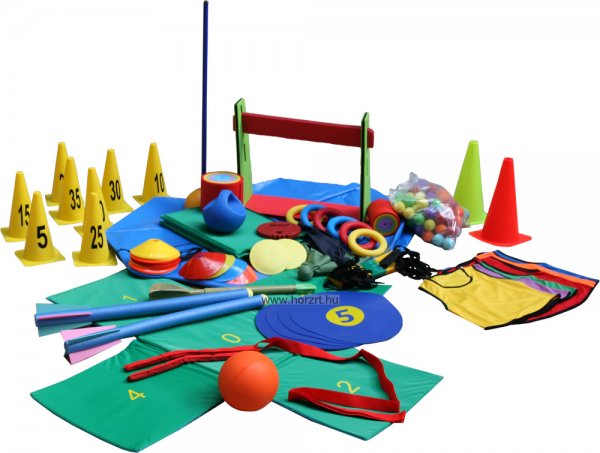Versatile usability of the devices of kids’ athletics in physical education classes
Vári Beáta

| Device | Item | Device | Item |
|---|---|---|---|
| Tool storage bag on wheels | 1 | Cross-shaped jumping mat | 1 |
| Medicine ball | 2 | Catch Tail Ball | 4 |
| Soft athletics discus with 3grips | 1 | Foam javelin | 2 |
| Soft athletics discus | 2 | Plastic javelin | 2 |
| Disc cone marker | 4 | Special tape measure 20 m | 1 |
| Tactics sheet for 100cm bar | 14 | Special tape measure 50 m | 1 |
| Workout bar | 14 | Vaulting pole | 2 |
| Color throw ball | 100 | jumping-rope | 1 |
| Rubber rope | 1 | Target discs for pole vault | 1 set |
| Foldable gymnastics mat | 4 | Disc cone marker set | 1 |
| Coordination ladder | 1 | Disc cone marker | 40 |
| Children's hurdle | 14 | Soft rings | 6 |
| Medicine ball with a grip | 2 | Partition ribbon | 1 set |
| Team vests | 60 | Event board with captions | 1 |
| Task sheets | 1 set |
Children's competitions are usually scaled-down versions of adult competitions; however, this is a wrong perspective since it leads to premature specialization and prevents the harmonious development of the child. It is disadvantageous also because it suggests such ideas to children, which are not appropriate for their age.
The IAAF ( the International Association of Athletics Federations) has set as its target (based on a number of research and experimental data) to introduce such form of athletics that can easily fit into the child's developmental needs.
In spring 2001 the IAAF Kid’s Athletics Working Group developed a concept that is distinctly different from the adult model of athletics. This new model is called the IAAF KIDS’S ATHLETICS and aims to make athletics the most practiced individual sport in all schools all over the world.
In Hungary the training started in 2012, whereby, over the period of two years, the Faculty of Physical Education and Sport Sciences trained 2008 teachers on how to teach physical education to children of 6-12 years of age within an athletic approach.
Organizational objectives
- Simultaneous training of many children
- Children need to experience various and simple forms of movement so that not only faster and stronger pupils can achieve good results
- Expectations should be tailored to children's age and coordination abilities
- The programs should be made an adventure
- Design and evaluation of the events is simple
- There is no need for many organizers, judges
- Athletics should be a coeducational event
Content objectives
- Teach the children to use their energies to preserve long-term health
- Gradual increase in the difficulty of game forms should contribute to the harmonious overall development of pupils
- Teamwork (boys and girls together) is the fundamental principle
(References: IAAF Kids; Athletics, children's team competitions)
Beyond the tasks and exercises set by the program the tools and devices can be used and combined in many-sided ways. Without being exhaustive, we intend the described and presented exercises to be thought-provoking. The creativity of physical education teachers is essential when using these devices. The tasks are described according to age groups and devices. The tasks can be carried out individually, in pairs, or as a team; this, as well as setting up the rules, is left up to the teacher. Most practices can be found in all three age groups, but in a more and more difficult form.